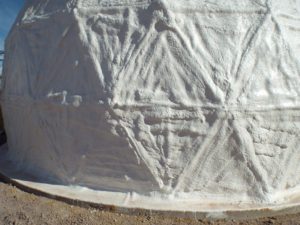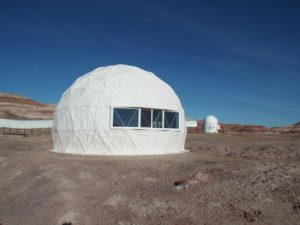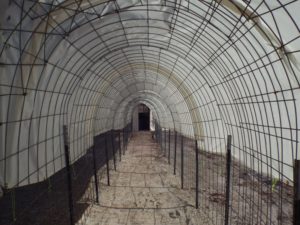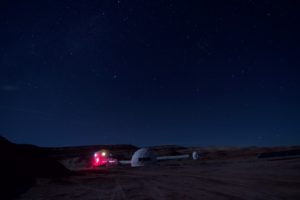Science Post – November 11th
The Science Dome
By Anushree Srivastava – Crew Biologist
To my great delight, I would like to let you all know that our Science Dome is operational now. For me, it is like a new home on the “Mars” where I am going to spend my time with our Crew Geologist Dr Jon Clarke and my other crew members who are being cross-trained into the science operations of Mars 160 mission. Dr Clarke and I would be performing the geological and microbiological, in other words, astrobiological experiments, inside the dome.
The white dome situated amid the reddish plateaus and stunning Mars-like landscape is the new feature of Mars Desert Research Station. The dome is connected to our habitat and observatory by surface tunnels. So we walk through the tunnels to reach the dome without space suits and thus not exposed to the harsh “Martian” environment. The dome is made of Styrofoam which is expandable and cost-effective and the crisscross pattern on its rough outer surface looks exotic and quite Martian! In the left side of the dome there is a power station and on the right side, we have laboratory shelves and equipment. The dome has a window that provides you the glimpses of beautiful “Martian” landscape, and in turn keeps you inspired to embark on the venture of human exploration of Mars. And surprisingly, sometimes when I hum in the dome my crew mates can hear me because it echoes J
Figure 1 a, b and c: Science Dome from outside. Image Credit: Dr Jon Clarke
Figure 2: Tunnel connecting dome with the habitat. Image Credit: Dr Jon Clarke
Figure 3: The hab and science dome in the night. Image Credit: Dr Alexandre
The dome is equipped with standard laboratory facilities and it is going to host advanced equipment and technologies to facilitate in-depth astrobiological study in a simulated Martian environment. Here the Mars Society’s long-term Martian simulation mission stands out because it principally focuses on the science operations, both inside the science laboratory and on the field during intense EVAs in coordination with human factors research. Under the auspices of Mars 160 mission the three principal science projects, which are lichen biodiversity, hypolith abundance and molecular analysis, as well as the exploration of ancient evaporites from astro-geo-microbiological perspective. Planned geoscience work will consist of soil moisture content by gravimetric analysis and measuring both soil electrical conductivity and pH by the 1:5 method. The lab will also provide a convenient working space to preserve samples in order to send them back to our Earth-based science team situated at NASA Ames Research Centre and Canadian Museum of Nature in Ottowa.








